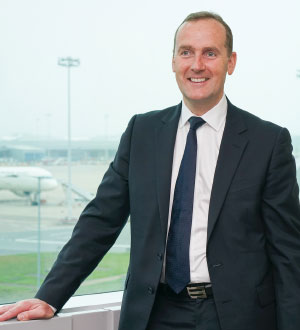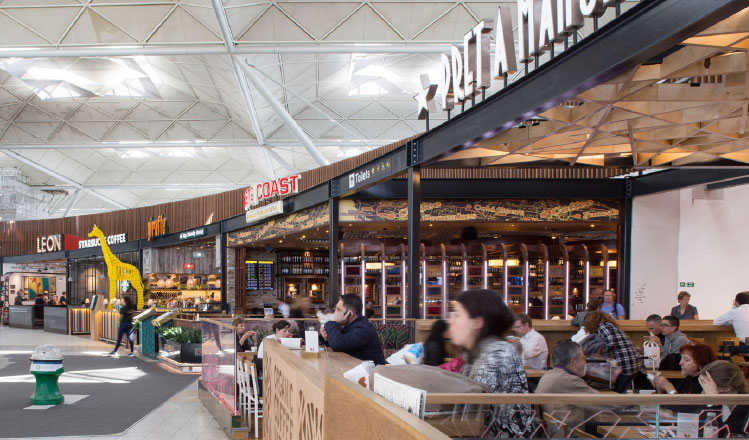Andrew Cowan, Divisional CEO, London Stansted Airport, interviewed by Ross Falconer.
London Stansted has many reasons to celebrate this year: the 25th anniversary of its opening in 1991, burgeoning traffic figures, and the arrival of British Airways’ first scheduled services from the airport, being among the most prominent.
Today, Stansted serves over 170 destinations and 23 million passengers a year, compared with less than 50 routes and 1.1 million passengers when it opened in 1991. It is the UK’s busiest single-terminal airport and firmly established in Europe’s top 25.

Andrew Cowan, Divisional CEO, London Stansted Airport: “Airports, in my mind, have a symbiotic relationship with local communities, local businesses, and other local stakeholders – they support economic growth.”
Stansted is at the heart of a booming catchment area, and since it was acquired by Manchester Airports Group (MAG) in February 2013 has entered a period of unprecedented growth, adding six million passengers. The latest figures for May appropriately show a 25th consecutive month of growth in the airport’s 25th year, with a 2.7% increase, signalling that it is on track to handle a record 25 million in 2016.
Andrew Cowan joined London Stansted as Divisional CEO in April, bringing a wealth of very relevant experience. He was most recently Chief Strategy Officer for MAG with responsibility for the whole Group’s long-term strategy, having joined in 2013 as Chief Operating Officer of MAG and Managing Director of Manchester Airport. It is also worth noting, in the context of the airport’s continued development, that prior to his MAG appointment Cowan was Chief Executive of Robertson Group – an infrastructure, construction and services company operating throughout the UK.
Reflecting on the first two months in his new role, Cowan enthuses about the “fantastic, passionate people here at Stansted, who are committed to doing a great job” as well as “just how far the airport has come in the last three years”. Indeed, following MAG’s acquisition, the terminal has undergone an £80 million (€100m) transformation, along with an £11 million (€14m) upgrade to the Satellite One departures area.
“It’s a hugely exciting time in the aviation industry and I’m looking forward to continuing the drive to attract new airlines to serve the vibrant London market and burgeoning Eastern England region, and further improving the customer experience,” Cowan comments.
Stansted has played a significant role as a major London airport competing for passengers and attracting new airlines over the past 25 years, during which the sector has dramatically changed and evolved following the emergence of the low-cost carriers. “We have a long-term deal in place with Ryanair, and are seeing them growing rapidly. easyJet is also continuing to grow with a good route mix,” Cowan notes. “One of the things I would like to see over the longer term is transatlantic routes and also flights to the Middle East. Getting that richer mix of carriers is one of our ambitions in the next 12 months. But I do think that the main growth here will be from the low-cost carriers, which remain the heartbeat of the business.”
Significantly, British Airways has begun operating from Stansted for the first time, with five summer seasonal services to Faro, Malaga, Palma, Ibiza, and Berlin. It is, Cowan says, “a clear demonstration of the strength of demand that exists across the region.”
“Symbiotic relationship with local communities”
The airport has been a key catalyst for economic growth and jobs, helping connect thousands of businesses along the London-Stansted-Cambridge innovation corridor with the global marketplace, and securing vital inward investment opportunities.
“Airports, in my mind, have a symbiotic relationship with local communities, local businesses, and other local stakeholders – they support economic growth,” Cowan explains. “If you look at Stansted, about 50% of our traffic doesn’t originate from this region, it originates from overseas. Therefore, it is really important that we have a very strong relationship and understanding of the community’s needs and the local economy.”
Stansted has grown to become the largest single employment site in Eastern England, with over 11,600 people working at the airport. Meanwhile, of MAG’s current 1,400 employees, over 100 have worked at the airport for its full 25 years. The commitment to community can be vividly seen at Aerozone Stansted – an education centre which opened last year to boost STEM skills (Science, Technology, Engineering and Maths) and showcase airport apprenticeships and careers to young people.

Phase 2 of London Stansted’s £80 million (€100m) transformation increased the choice of cafés, bars and restaurants with the arrival of 12 new offers, including airport firsts, traditional favourites, and the airport’s first-ever Escape Lounge.
“The Aerozone is our flagship community project here at Stansted and it represents a long-term commitment to our community,” Cowan says. “Engaging with young people, particularly those living in areas close to the airport, is a vital part of our community work. The aim of the centre is to inspire young people to consider the varied apprenticeships and career opportunities within aviation, focusing on the vital STEM subjects that generate real prospects for young people and open their eyes to the fantastic opportunities available on their doorstep.”
Building on Stansted’s recent transformation, which has seen the security area relocated and doubled in size, and the retail and food & beverage offer revitalised, Cowan is looking ahead to an ongoing investment programme to improve passenger services and facilities. He explains that this will include upgrading hold baggage screening equipment, car parking facilities, check-in areas, and seating.
While its 25th anniversary is an opportune time to reflect on past achievements and progress, Stansted is clearly responding to rapid growth with a firm focus on the developments needed to meet demand and secure a future that promises to be just as exciting and fast-moving as the past 25 years.







